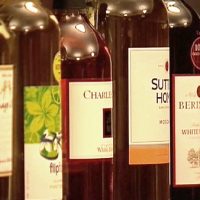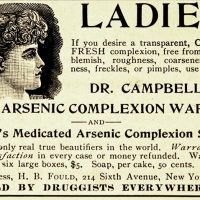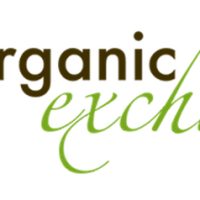
By Rick Riozza
Some of us wine lovers out there have a worn out T-shirt lying around that says “Life’s too short to drink cheap wine”. Well—it seems that’s just what four plaintiffs are claiming in a lawsuit filed last week in California against 28 notable wine companies. Their position is that many cheap wines in the market place have way too much toxin arsenic —that popular brands including Franzia, Korbel, and the infamous two-buck Chuck, Charles Shaw — are laced with arsenic at up to five times the level of what’s considered safe.
According to the class-action suit, “just a glass or two of these arsenic-contaminated wines a day over time could result in dangerous arsenic toxicity to the consumers.” Since California wines make up nearly 90% of the U.S. wine industry, American wine drinkers have become the “unwitting ‘guinea pigs’ of arsenic exposure,” the suit alleges.
As one would expect when an incendiary lawsuit is filed against a 23 billion dollar industry, many of the wine trade groups are already disputing the lawsuit’s claim as “false and misleading”.
I went on-line to check out the “claim” which of course neither judge nor jury has weighed in on, but it’s interesting to see if our favorite “cheap wine” is listed as a culprit of doom. Enumerated are 83 specific brand names with specific varietals, with a lot of cheap White Zins and sweet Moscatos taking the hit.
Of course no one is making light of arsenic poisoning. History (and the lawsuit’s informative intro) tells us such poisoning took down the likes of Napoleon Bonaparte, Simon Bolivar and King George III. And we know that long-term exposure to inorganic arsenic, mainly through smoking, drinking contaminated water, eating food prepared with contaminated water or eating food irrigated with arsenic-rich water, can lead to health risks such major headaches, skin lesions, and cancer.
But arsenic is found in air, soil and water throughout the world. Therefore, it can also be found in grains, fruits, vegetables and seafood due to absorption through soil and water. I even discovered that there is “organic arsenic” that’s not particularly toxic—such as in oysters, which are very high in it. I was happy to read that, so in celebration I downed a few of those raw bivalve mollusks with some good (i.e.—not cheap!) Chablis.
“Plants take up trace amounts of arsenic from the soil, and we have been ingesting these trace amounts for all of human history. Generally, these amounts are at levels well below that associated with either acute or chronic toxicity,” said Cornell University’s Gavin Lavi Sacks.
The first time the U.S. Food and Drug Administration set limits for arsenic levels in food or drink was in 2013, when it proposed to limit the amount of inorganic arsenic in apple juice, as with drinking water, to 10 parts per billion.
So here comes the big contention: The lawsuit insists that arsenic in wine should meet the same thresholds and standards as drinking water. But there are no such standards for wine in this country. Definitely a “brew-ha-ha” in the making.
FDA spokeswoman Lauren Sucher said in an email to CNN: “People drink far more water than they do wine over their lifetimes, and they start drinking water earlier in life. Thus, both the amount and period of exposure are different and would require separate analyses,” she said.
A corollary from her argument would be that anyone drinking the same amount of wine as they should be drinking water (at 2 liters/10 cups a day) has bigger problems. Enjoying two to three five-ounce glasses of wine a day isn’t that significant an arsenic dose—but of course, no one likes the idea taking in any real amount of arsenic in our systems.
Countries that import California wine also test for arsenic using their own standards: 100 parts per billion in Canada and 200 parts per billion in Europe—10 to 20 times higher than the drinking water limit in the United States. These standards will no doubt fuel the defense team’s arguments.
A question I have is: what about “high end” wines (which probably have their little share of arsenic)—why aren’t they targeted? I guess it’s a rhetorical one, for my legal training tells me that “high end” wine companies weren’t named in the suit—thus, that matter is irrelevant. The political/legal field sees much more bucks targeting many million cases of wine: who wants to sue a great wine company that puts out only a few thousand cases or less.
I recently spoke to Grgich Hill’s assistant winemaker, Kevin Vecchiarelli, about the action. He had his personal comments; however, he assured me that Grgich Wines continually fall way under the 10ppb standard of drinking water—they’ve always practiced sustainability.
Of course an article on toxins in wine would not be complete without hearing from our organic wine gal, Annie Arnold, owner of the Organic Wine Exchange where we can all drink pesticide & fungicide free wine from her vast portfolio of wines produced organically around the world.
I just saw Annie at the Palm Desert Wine & Food Festival. “Arsenic is a tricky topic.” She continued, “As much as I would like this publicity to benefit the organic market, I believe it’s too early to make harsh judgments on either side of the argument.
“I believe this is a wake-up call. The fact remains that there is a lot going on in the wine industry that consumers are unaware of due to non-disclosure or ingredient labels. Modern day wine can have a lot of vineyard chemicals still in it and additives can be added to change the flavor, texture, taste and aroma. To be honest, more than arsenic, I would rather see results of lab tests done on wine that reflect the amount of pesticide residual and additives.”
Cheers to that!—Drink safely!















































